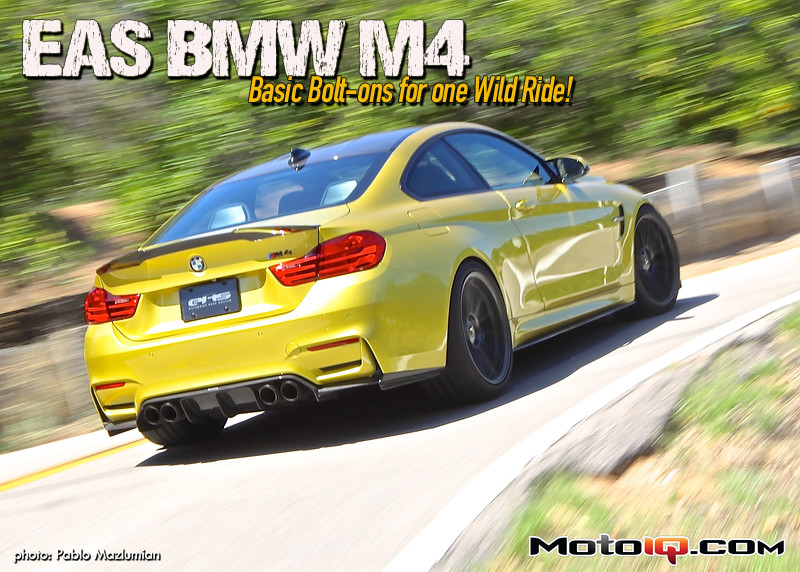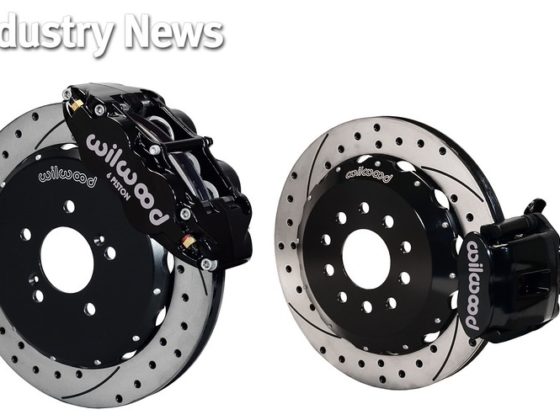,

To prove our point about the F8X BMW M3/M4, here is a baseline dyno graph, as tested by EAS on its Dynojet 248C. Again, this car is rated at 425bhp and 406 lb-ft from the factory, and yet that’s 414 wheel-horsepower and 410 LB-FT of torque to the wheels you’re witnessing there. No wonder these cars are trapping so fast in the quarter-mile. BMW could have given them a 485 “bhp” rating, and no one would have ever called “bull” (to see SAE correction vs STD, multiply the STD number by .974, which gives us 403 WHP).
When comparing the S55-powered BMW M3/M4s versus the outgoing S65 V8-powered M3s, the performance of the turbocharged inline-six will trounce the performance of the older V8, even though the V8 is rated at just 11 BHP less.
The above comment isn’t meant to take anything away from the technological marvel of the S65 V8. After all, getting 100 brake horsepower per liter from a normally-aspirated V8 is awesome, and some owners are even getting 100 wheel horsepower per liter with bolt-ons and a good tune! It's just that each succeeding generation of car (i.e. the Ferrari 458 vs the turbocharged Ferrari 488, or the first generation Mercedes AMG E63 versus its successor, the turbocharged E63) has gotten so much faster with boosted technology.
Improving performance via turbocharging, however, is not without sacrifice. For many, this means a less-desirable engine note coming from the exhaust pipes (been watching Formula 1 these past couple of years?). And many BMW and Ferrari purists are not willing to trade the audible experience for more power, greater fuel economy, or even gobs more torque.
In any case, my point with the above “trouncing” statement was just to debunk the similarity in BHP-rating between the two cars. That power difference to the wheels is way more than just 11 horsepower, believe me! See below…

So, here is the BMW M4 (red line) versus the E92 V8 M3 (blue line). Does anyone else see anything wrong with this picture? While the factory says “11 BHP”, the dyno says 60 WHP at a point (the very top) where the delta is the smallest! Thanks to the turbos, the area around the curve is also much greater, even with less displacement. In fact, there are areas with over a 100 WHP difference! That's the advantage of turbocharging done right. The old V8 doesn't stand a chance this way.
 When discussing the “area under the curve”, we're basically talking torque. First, notice the M4 baselined with 411 LB-FT of torque, when it was rated 406 LB-FT at the flywheel. Second, on paper, the V8 S65 M3 should only be 111 lb-ft behind the new M3/M4 (295 lb-ft versus 406 lb-ft, respectively). Yet here we see a difference of nearly 150 LB-FT!
When discussing the “area under the curve”, we're basically talking torque. First, notice the M4 baselined with 411 LB-FT of torque, when it was rated 406 LB-FT at the flywheel. Second, on paper, the V8 S65 M3 should only be 111 lb-ft behind the new M3/M4 (295 lb-ft versus 406 lb-ft, respectively). Yet here we see a difference of nearly 150 LB-FT!Given the displacement, it's not hard to believe that the S55 3.0-liter twin turbo engine was based off the N54 3.0-liter twin turbo engines found in the 135/335/535 BMWs (among others). But, while it's true, it doesn’t mean that the two engines are the same.

Even though the displacement is the same between the S55 (BMW M4) and the N54 (BMW 335i), it would take a lot of modifications to a 335 in order to have it surpass the performance of the new BMW M3/M4. That’s a difference of 124 WHP between the two right there!
In order to make that extra 124 WHP last, BMW reportedly beefed up the internals to withstand more RPM, as well as addressed other issues that were experienced in the 335 like cooling and fuel delivery. The turbos are also slightly bigger than the units found in the N54 (the N55 found in the later 335i is a twin scroll single-turbo), and the block on the S55 is a closed-deck design that it is more tolerant of these higher cylinder pressures.

Here is the difference between the two engines in terms of torque. Using the same displacement, BMW has been able to match the spool-up characteristics of the 335i's smaller turbos, and also turn the M3/M4's torque curve into a much flatter delight that's still seeing over a 100 more lb-ft of torque at redline.



